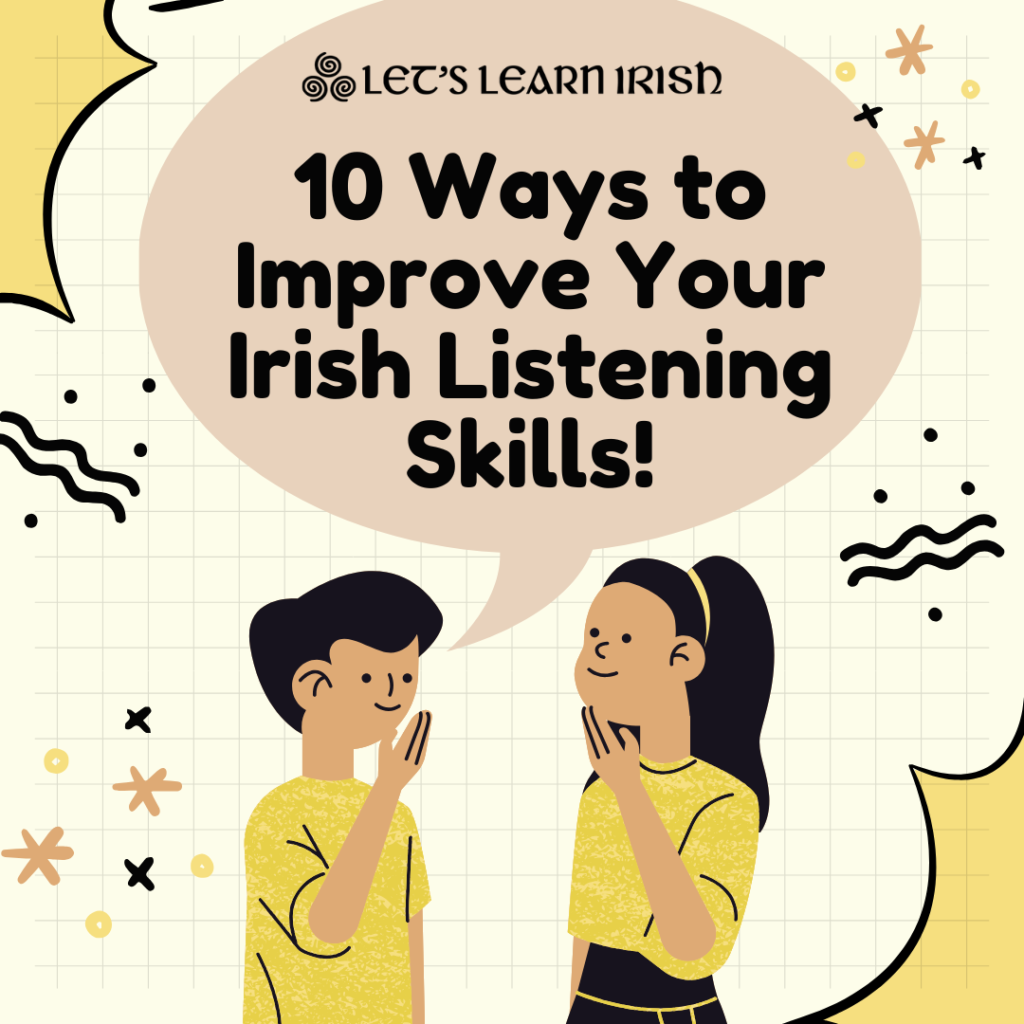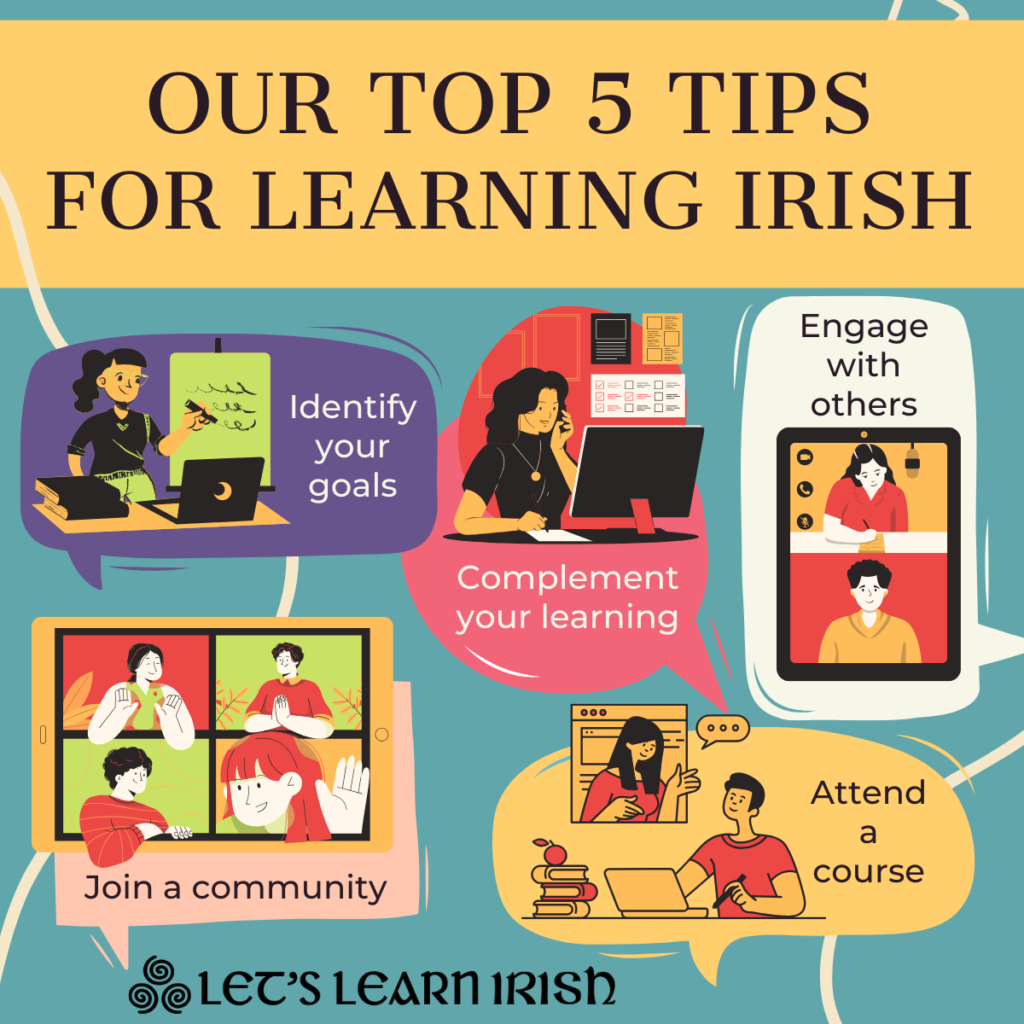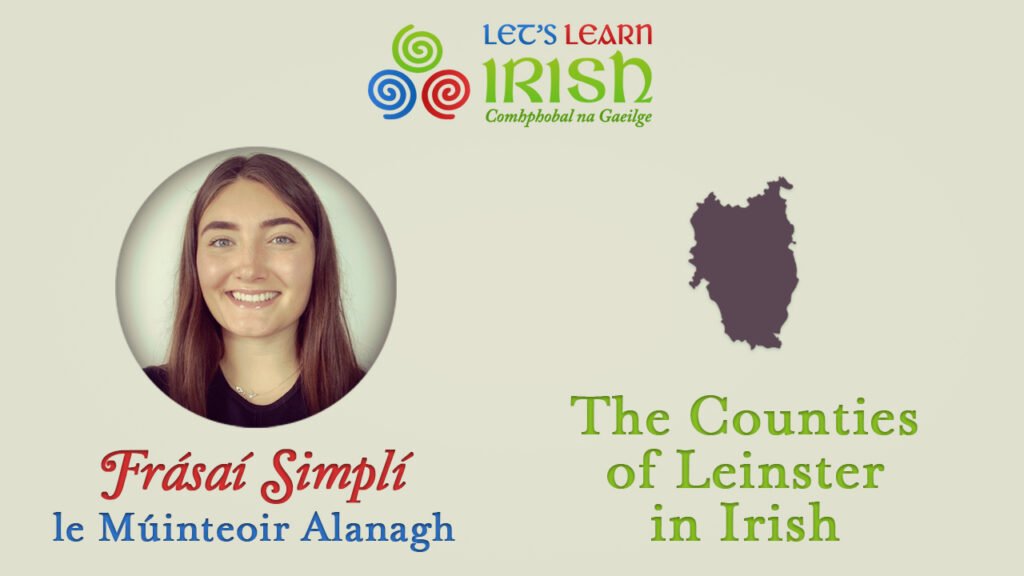10 Places to Visit in the Gaeltacht
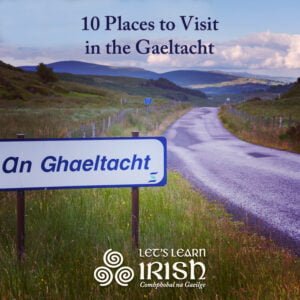 ‘The Gaeltacht’ refers to areas in Ireland in which Irish is the primary language spoken in the community. Spread over all four provinces, these locations are deemed some of the most “authentic” areas of the island, maintaining a rich culture and heritage from which Ireland draws its identity. For that reason alone, there are many amazing places to visit in the Gaeltacht.
‘The Gaeltacht’ refers to areas in Ireland in which Irish is the primary language spoken in the community. Spread over all four provinces, these locations are deemed some of the most “authentic” areas of the island, maintaining a rich culture and heritage from which Ireland draws its identity. For that reason alone, there are many amazing places to visit in the Gaeltacht.
Whether you’re looking to use your Irish in real life or simply want to explore the most traditional parts of Ireland, a trip to the Gaeltacht should be on your agenda. To help you out, here’s our list of 10 destinations to visit in the Gaeltacht, each unique in its own way. To make it simpler, we’ve grouped them by counties.
Contae Dhún na nGall (County Donegal)
1. Gaoth Dobhair (Gweedore)

Sometimes referred to as the “cradle of Irish culture,” there are plenty of reasons to visit this remote village in the northwest of the island. The stunning landscape that includes a coastline full of coves and bays, as well as Mount Errigal further inland, only complements the old Irish customs and traditional music found in the town. In addition to having the world’s smallest harbor, Gaoth Dobhair is also said to be the most densely populated village in Europe. Considering it is the largest Irish-speaking parish in Ireland, it is not a surprise that it is home to the northwest regional studios of the Irish-language radio service RTE Raidio na Gaeltachta and indeed, some of the very best Irish podcasts that you’ll find!
While you’re in Gaoth Dobhair you might want to stop at the nearby village of Meenaleck, which is where you can find Tábhairne Leo, perhaps Donegal’s most famous pub. In addition to regularly hosting some of the best music around, it is also the home of Irish music legends such as Enya, Clannad and Moya Brennan. Rann na Feirste (Ranafast) is another local picturesque town in the Donegal Gaeltacht worth visiting, where you can see Eas a’ Ranca, or the Assaranca Waterfall.
2. Árainn Mhór (Arranmore Island)
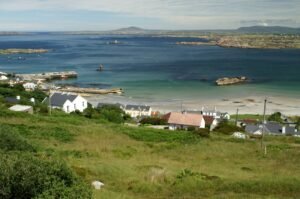
With 478 inhabitants, Árainn Mhór is Donegal’s largest inhabited island, with its citizens speaking Ulster Irish. Settled since prehistoric times, and with a coastal fort dating back to 800 BCE, the island is steeped in history. For those looking for a quiet getaway with traditional music, open turf fires in pubs and a pint of Guinness, this is one of your places to visit in the Gaeltacht. In addition to getting a taste of island life, there are many great walking trails on Árainn Mhór.
Contae na Gaillimhe (County Galway)
3. Conamara (Connemara)
Located west of Galway City, Conamara is Ireland’s largest Gaeltacht. For that reason, it is home to many programs and services centered on the Irish language. For example, TG4 Teilifís na Gaeilge Studios (more commonly known as simply TG4), is Ireland’s Irish-language television network and is located in the heart of rural Conamara. Similarly, the Irish language institute Acadamh has one of its centers in Ceathrú Rua (Carraroe) on the southern coasts of Connemara, and Telegael, the award-winning production company, is located east of there, in An Spidéal (Spiddle).
One may, however, go to Conamara for the landscape alone. Connemara National Park’s 2000 hectors (4942 acres) include mountains, bogs, heaths and woodlands that lend a mystic quality to the area. You can hike Diamond Hill in Letterfrack,or enjoy the grounds of the Kylemore Abbey Estate, home to Benedictine nuns. Conamara also includes many vibrant, charming towns, including Leenane and Roundstone, making it one of the places to visit in the Gaeltacht that offers the most options to choose from.

4. Na hOileáin Árann (The Aran Islands)
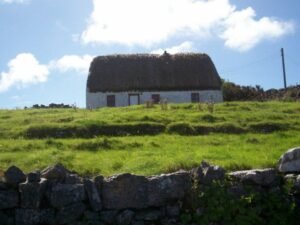
The three Aran Islands, Inis Mór (Inishmore), Inis Meáin (Inishmaan), and Inis Oírr (Inisheer) are located in Galway Bay and collectively one of the most visited tourist attractions in the West of Ireland (after the Cliffs of Moher). Inis Mór is the largest island with 800 inhabitants and held the Red Bull Cliff Diving Series in 2014 and 2017. It also contains ruins such as Dísert Bhreacáin, or the Seven Churches, which were believed to be built in the 7th or 8th century, as well as Teampall Bhreacáin (St Brecan’s Church), which was used from the 8th to the 13th century.
Inis Meáin, the middle island, is the least visited but thought to be the most unhindered by tourism. Inis Oírr is the smallest, measuring 3km by 3km, and includes the shipwreck of the Plassy, as well as one of the most famous trad music bars in Ireland. You can take a ferry or small plane to any of these islands. Once there, you’ll find the locals hospitable and willing to share their culture, as they are one of the most common places to visit in the Gaeltacht, especially in the west.
Contae Chiarraí (County Kerry)
5. Baile an Sceilg (Ballinskelligs)

Perhaps one of the best-kept secrets regarding places in the Gaeltacht, Baile an Sceilg is near, but not on, the famous Ring of Kerry. Hence, many people miss this Irish-speaking village. Located near the Skellig Islands (the largest being a fourth-century historical monastic site and the other an important bird sanctuary), Baile an Sceilg also has a beach, for those looking to relax after a long day of speaking Irish. Because it experiences less tourism, Baile an Sceilg offers the experience of an authentic Irish experience and great chance to try out your Irish language skills.
6. Daingean Uí Chúis (Dingle)
Although less than 15% of people in Daingean Uí Chúis (known to most people as Dingle) speak Irish on a daily basis, it is still best not to overlook this popular tourist destination. In addition to a large collection of ogham stones from the 4th and 5th century, Daingean Uí Chúis has been an important port town throughout history. If you visited between 1983 and 2020 you would have undoubtedly heard of Fungie, a bottlenose dolphin that entertained tourists and locals alike for almost four decades. However, even if Fungie is no longer in action, you can enjoy ocean life firsthand by going for an adventure (and practice your Irish) with Dingle Sea Safari, led by Múinteoir Jamie from Let’s Learn Irish!
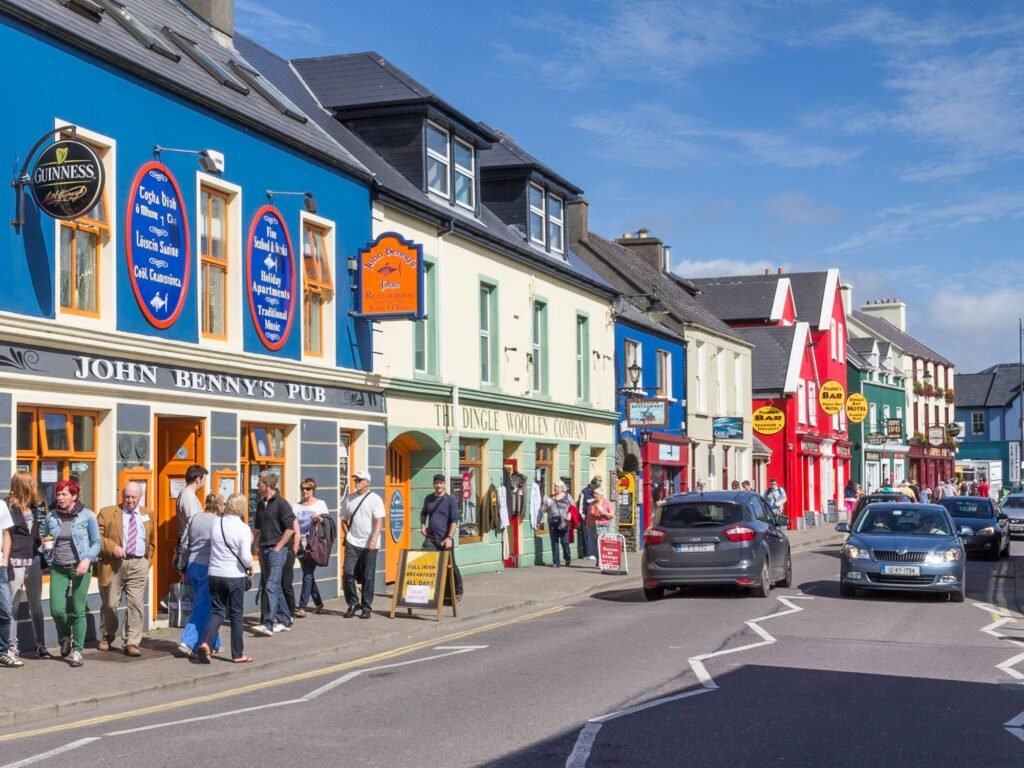
Contae Mhaigh Eo (County Mayo)
7. Acaill (Achill Island)
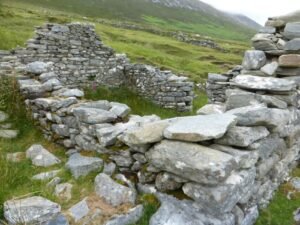
The largest island in Ireland is believed to have had people settled on it since 3,000 BC. Although most inhabitants speak English first in the community, half of the island is in the Gaeltacht. An island rich in history, one of the most interesting attractions might be The Deserted Village. Located close to Dugort, the Deserted Village contains the ruins of approximately 80 houses that were abandoned during the Great Famine. Not much is known about the Deserted Village, other than locals grazed cattle there until the 1940s.
Contae na Mí (County Meath)
8. Ráth Chairn
Ráth Chairn (spelled in English as Rathcairn) has perhaps one of the most interesting stories as an Irish-speaking place: it is the only constructed Gaeltacht. In 1935 the Land Commission relocated 27 families from the overpopulated district of Ceantar na nOileán in Conamara. Each family was given 22 acres, a sow, piglets and basic farming implements. Two years later, 11 more families joined them. One of the motivations of the Land Commission, in addition to relieving congestion in the west of Ireland, was to create a Gaeltacht in the east and try to stem what they saw as the “cultural loss” emanating from Dublin. Ráth Chairn, as well as nearby Baile Ghib—who experienced a similar history, make up the smallest Gaeltacht in Ireland. Ráth Chairn may not be on everyone’s list of places to visit in the Gaeltacht, but with such an interesting past, it’s certainly worth checking out.
Contae Phort Láirge (County Waterford)
9. Gaeltacht na nDéise
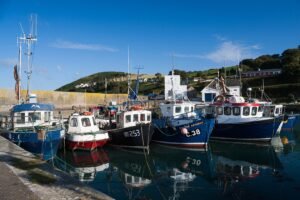
Together, the two small coastal towns of An Rinn (Ring) and An Sean Phobal (Old Parish) make up the Waterford Gaeltacht in the southeast of the country, collectively called Gaeltacht na nDéise. Gaeltacht na nDéise is one of the few Gaeltacht areas to have actually gained Irish speakers between the 2011 and 2016 census, totaling over 1700 people using Irish on the last count. Here, local natives speak ‘Gaoluinn na nDéise’, the Waterford variant of the Munster Irish language dialect.
An Sean Phobal, a village in west County Waterford, has an interesting connection with Chicago. The grandparents of Richard J Daley, a long-serving mayor, came from this parish, and Daley’s son, Richard M. Daly, also served as mayor in Chicago.
Contae Aontroma (County Antrim)
10. An Cheathrú Ghaeltachta (The Gaeltacht Quarter, Belfast)
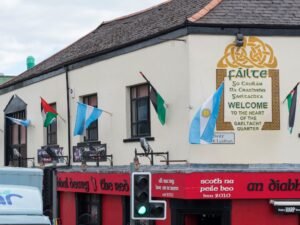
Although not yet officially recognized as a Gaeltacht area, the Gaeltacht Quarter in West Belfast is a must-see place to visit. Growing out of The Troubles (1968 to 1998), the western part of the city, particularly around Falls Road, has become an area deeply committed to preserving and promoting Irish culture. As such, a significant portion of population there speaks Irish, and the teaching of the language is highly endorsed. Here you will find the long-established ‘Raidió Fáilte‘, the Irish-language radio station, and Cultúrlann McAdam Ó Fiaich, which hosts a multitude of cultural events. All language learners have to check out the fantastic selection at one of our favorite bookstores, ‘An Ceathrú Póilí‘!
Any visitor to An Cheathrú Ghaeltachta will have plenty to enjoy. For those who appreciate drama, Aisling Ghéar is an Irish-language experimental theater company based in West Belfast that has gained international recognition. You might be in the city during the right time to enjoy the work of Féile an Phobail, Ireland’s largest community arts festival. One of its programs include Féile an Earraigh, which celebrates Irish and Celtic art, culture, music and language. There are also a variety of tours through An Cheathrú Ghaeltachta, including the well-known Black Taxi tours.
The Online Gaeltacht
11. Gaeltacht.net (Let’s Learn Irish)
 Unfortunately, not everyone has the chance to travel, and those who do must eventually return home. However, the good news is that they can still be an active part of a Gaeltacht: more specifically, the global online Gaeltacht.
Unfortunately, not everyone has the chance to travel, and those who do must eventually return home. However, the good news is that they can still be an active part of a Gaeltacht: more specifically, the global online Gaeltacht.
The ability of Irish to grow and thrive depends on people taking up the language, including those outside of Ireland. In addition to taking courses to learn Irish, Let’s Learn Irish offers comhrá sessions and interactive workshops so that you can be a member of the online Gaeltacht and participate in the Irish language revival.
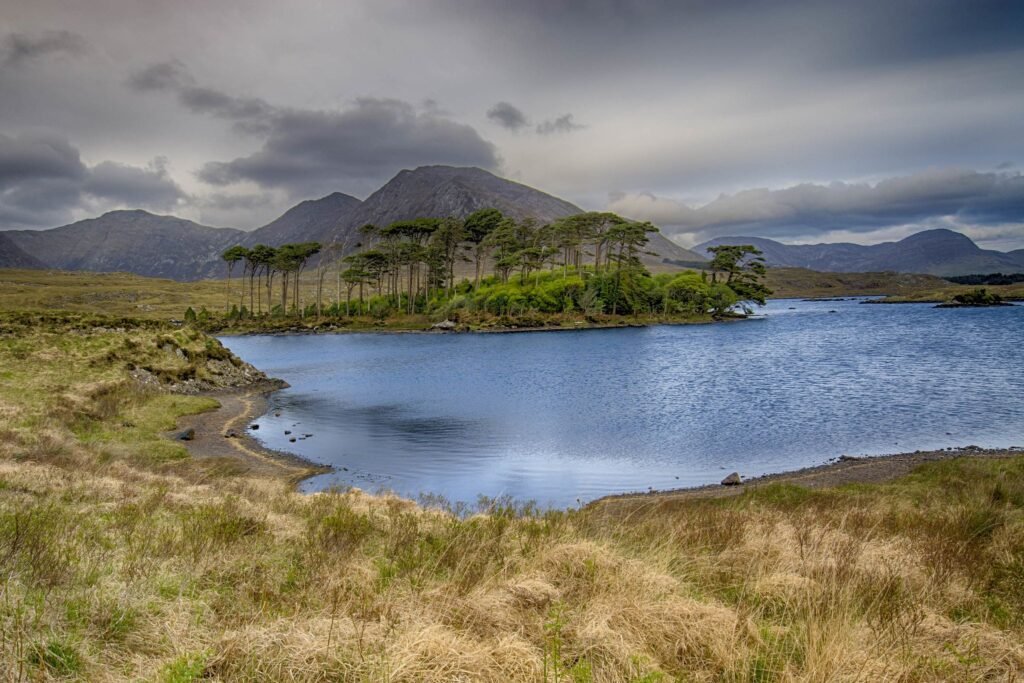
The Gaeltacht, spread throughout Ireland (and in some ways the whole world), offers many diverse, vibrant places to embrace ‘an Ghaeilge’. One can probably spend a lifetime exploring all that the Irish-language areas have to offer, with each town or region providing something a little different. No matter where you go, you’ll be in a place surrounded by magnificent landscapes, upholding the traditional Irish culture in many ways, and embedded deeply in a long history. Even better, whether you are fluent in Irish or only have a ‘cúpla focal’ (a few words), you’ll get to use the language in a place that thrives on it.
Bígí páirteach!
Join the online Irish community at LetsLearnIrish.com.
Follow on social media @LetsLearnIrish.


